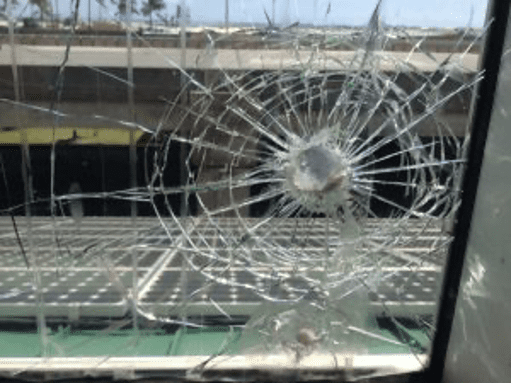
Bullet-resistant glass and safety film are essential to the safety of the general public. The recent insurrection at the Capitol Building in Washington, D.C., is a prime example of the necessity of bullet-resistant glass and safety film. As witnessed in various photographs and video clips, rioters were able to easily and quickly smash the windows of the Capitol Building.

What’s the bottom line?
Whether you are trying to protect a government building, bank, restaurant or your very own home, bullet-resistant glass and safety film will provide you with unmatched protection. When choosing between the two, understanding the capabilities of each is crucial. So, what sets bullet-resistant glass and safety film apart?
What Is Bullet-Resistant Glass?
Bullet-resistant glass is a transparent material that can resist the penetration of forced entry, projectiles, and explosive blasts. It’s ability to protect against these threats depends on its Underwriters Laboratory 752 Level (1-10), or UL Level for short. The UL Levels range from 1 to 10, the higher the level the stronger the glass.
There are several different types of bullet-resistant glass, the most common are insulated ballistic glass, monolithic acrylic glass, polycarbonate glass, laminated glass and glass-clad polycarbonate. These materials vary in their UL Levels. For example, insulated ballistic glass protects against UL Level 1 threats, perfect for schools or community centers. However, glass-clad polycarbonate protects against UL Level 1 through 8 threats, better for police stations, government buildings and even air force bases.
Recently, BALLISTIGLASS partnered with Andrews Air Force Base, to ensure the safety of their employees and guests. The base was equipped with BallistiMAX glass, made of glass-clad polycarbonate. BallistiMAX is equipped with Ballistishock technology and can defend against the deadliest weapons including the AR-15 and AK-47.
Now…
Let’s uncover some myths.
Bullet-Resistant Glass Myths
- Myth: It is lightweight. Bullet-resistant glass is actually quite heavy, depending on the UL Level. Even a small square of glass could weigh dozens of pounds. This makes vehicular installation difficult.
- Myth: It is cheap. The glass can cost thousands of dollars depending what needs to be protected and how well it needs to be protected.
- Myth: It cannot break. Contrary to popular belief, bullet-resistant glass can be broken, but it takes a significant amount of force. For example, most bullet-resistant glass is blast resistant, but if an explosive were detonated within several feet of the glass, it would shatter.
BallistiMAX glass counters these myths with its lightweight (about half the thickness of classic bullet-resistant glass), cost-effective and durable nature. And it can be retrofitted to any existing window or glass door enclosure.

What is Safety Film?
Safety film, or security window film, enhances the safety of regular glass to protect against vandalism, forced entry and spalling (the shattering and spraying of glass shards). Safety film is composed of one or more laminated layers of polyester film. It ranges in thickness, generally 4 mils to 15 mils, sometimes thicker (for reference, 1 mil = 0.0254 millimeters). The thicker the film, the more durable it is.
Note, your car windshield is about 197 mils (or 5 millimeters) thick. Safety film is unique because it has the ability to reduce heat and protect against ultraviolet rays. And it can be applied directly to a window.
Here’s the deal, though:
There is quite a few myths regarding safety film.
Safety Film Myths
- Myth: It can prevent forced entry. Security window film can slow down an intruder by making it more difficult to enter, but it cannot completely prevent them from entering your home or business. Slowing down an intruder down allows for more time to run, hide, or call for help.
- Myth: It’s bulletproof. Security window film is not bulletproof. However, it can prevent glass that has been penetrated by a bullet from spalling.
- Myth: It is a primary method of defense. In addition to safety film, your home or business should be equipped with an alarm system, locks and other security devices. Safety film is pointless if your front door is unlocked.

Which One Should You Choose? Bullet-resistant glass vs safety film
You may be wondering…
Which option is better? The answer depends on what you are trying to protect, people or products. The chart below compares the two, showing the capabilities of each.
Bullet-Resistant Glass | Safety Film | |
Forced Entry | X | X |
| Projectiles (e.g., bullets) | X | |
Explosive Blasts | X | X |
| Spalling | X | X |
| Extra Response Time | X | X |
Security window film is a great choice if you are only looking to protect products. It will protect the windows and doors of your grocery, hardware or convenience store making forced entry difficult.
If you are looking to protect products and people, then bullet-resistant glass is the necessary choice. It can withstand all of the aforementioned threats while ensuring the people behind it have enough time to escape, hide or call for help.
Here’s the bottom line:
The best bullet-resistant glass creates an atmosphere of security, safety and peace of mind. And BallistiMAX glass can provide all three, whether you are a teller at a bank, a grocer, or a schoolteacher. That’s why our innovative product is currently protecting schools, houses of worship, historical monument visitors’ sites and government buildings across the country.
Author: Mary Qualls
